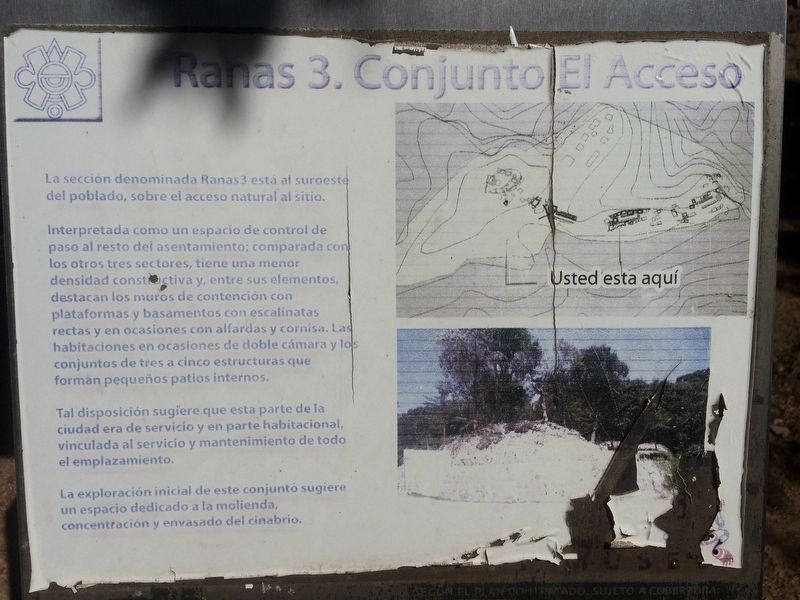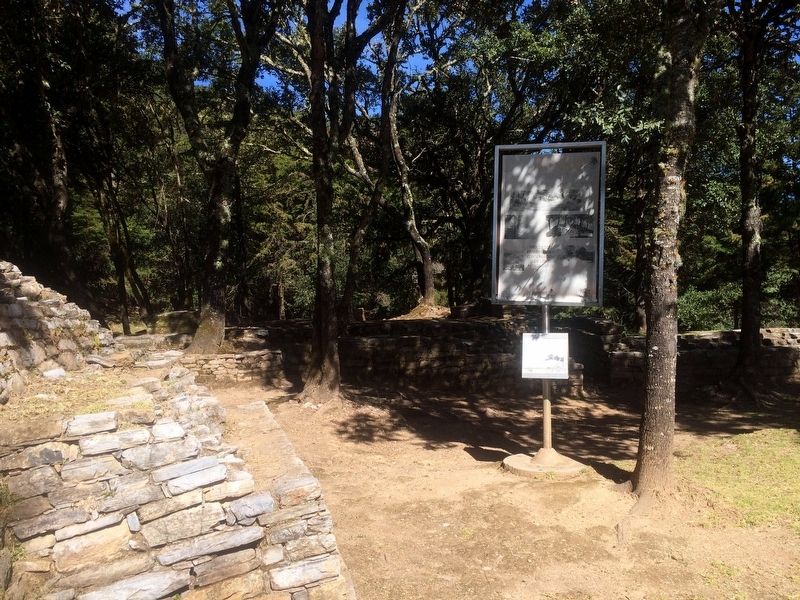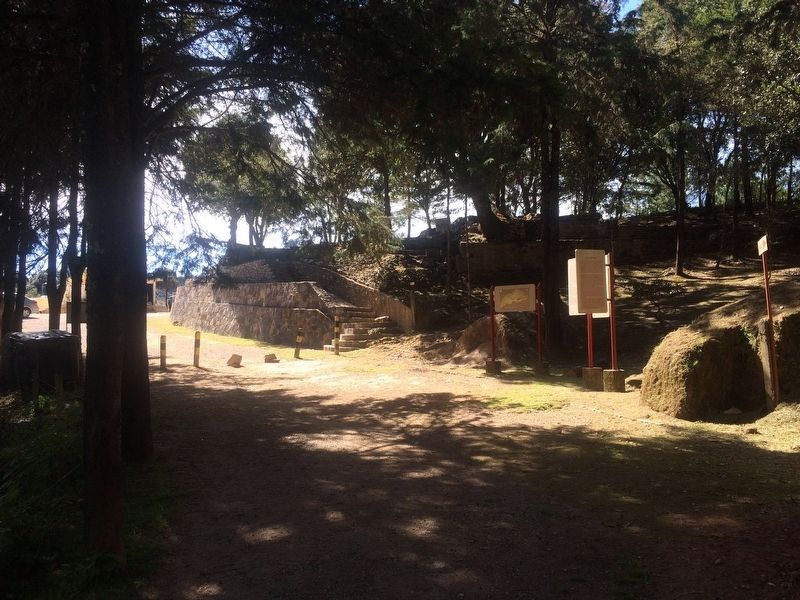San Joaquín, Querétaro, Mexico — The Central Highlands (North America)
Las Ranas and the Access Complex
Las Ranas
La ciudad antigua de Ranas fue edificada en la cima de dos cerros que se unen formando un vértice y sobre cuyas laderas se distinguen las secciones más relevantes de la ciudad. El emplazamiento posee un solo acceso natural por el poniente, rodeado por profundos barrancos. Tiene una ubicación geográfica estratégica, ideal para el control y explotación de la gran diversidad de nichos ecológicos y recursos minerales existentes en la región.
Lo áspero de la sierra permitió la integración de un patrón cultural único, que se distingue de otros por la ubicación de sus asentamientos menores: para llegar a ciertos puntos - manantiales bancos de material o tierras de cultivo - , era necesario transitar por una serie de rutas resguardadas por la población serrana, ya fuera de manera presencial o a distancia.
Desconocemos la fecha de fundación de la ciudad, pero sabemos que ya existía desde el siglo IV d.С., y que mantuvo actividades hasta el XIV.
Una de las condiciones que sirvió al desarrollo de esta sociedad fue la concentración en el lugar de recursos minerales, como el sulfuro rojo de mercurio o cinabrio, pigmento muy estimado en Mesoamérica, empleado como emblema de poder y riqueza; poseía una alta significación religiosa y era tenido por símbolo de vida, al ser equiparado con la "sangre de la tierra". El control de los yacimientos y de la producción de cinabrio aseguró a la población serrana una posición relevante en las redes de intercambio mesoamericanas.
Tanto en la arquitectura como en vasijas, conchas marinas y esculturas de la Sierra Gorda y, en particular, de la ciudad de Ranas, han sido identificados rasgos propios e imitativos de tendencias que tienen origen en Teotihuacan, Tula, Río Verde y, en general, en la costa del Golfo, siendo su vínculo más fuerte con esta última región.
Marcador adicional:
Ranas 3. Conjunto El Acceso
La sección denominada Ranas 3 está al suroeste del poblado, sobre el acceso natural al sitio.
Interpretada como un espacio de control de paso al resto del asentamiento; comparada con los otros tres sectores, tiene una menor densidad constructiva y, entre sus elementos, destacan los muros de contención con plataformas y basamentos con escalinatas rectas y en ocasiones con alfardas y cornisa. Las habitaciones en ocasiones de doble cámara y los conjuntos de tres a cinco estructuras que forman pequeños patios internos.
Tal disposición sugiere que esta parte de la ciudad
era de servicio y en parte habitacional, vinculada al servicio y mantenimiento de todo el emplazamiento.
La exploración inicial de este conjunto sugiere un espacio dedicado a la molienda, concentración y envasado del cinabrio.
Ranas
The ancient city of Ranas was built on top of two hills that join together, forming a vertex and on whose slopes can be seen the most important sections of the city. The site has a single natural access to the west, surrounded by deep ravines. It has a strategic geographical location, ideal for the control and exploitation of the great ecological diversity and mineral resources existing in the region.
The rough terrain of the sierra helped to create a unique cultural pattern, which was different from the situation in smaller, nearby towns: in order to reach certain important points – springs, mineral resources or farmland - it was necessary to travel through routes protected by the mountain population.
We do not know the date of the city’s founding, but we know that it existed as early as the 4th century and that it maintained activities until the 14th century.
One of the conditions that served the development of this society was the concentration of mineral resources, such as red mercury sulfide, also known as cinnabar, a highly valuable pigment in Mesoamerica, used as an emblem of power and wealth; it was very significant in the religions of the area and was considered a symbol of life, being equated with the "blood of the earth". The control of these deposits and cinnabar production assured the mountain population a relevant position in Mesoamerican exchange networks.
Both architecture and clay vessels, seashells and sculptures from the Sierra Gorda and, in particular, from the city of Ranas, have been identified as being similar to those from Teotihuacan, Tula, Río Verde and, in general, from the Gulf Coast, with the strongest link with this last region.
Additional marker:
Ranas 3. Access Complex
This section known as Ranas 3 is southwest of the village, near the natural access point of the site.
It has been understood to be an area of control related to the rest of the settlement. Compared with the other three sectors, it has a lower construction density and includes some retaining walls with platforms and bases with straight staircases and sometimes with stair railings and cornices. The rooms sometimes include double chambers and sets of three to five structures that form small inner courtyards.
This environment suggests that this part of the city was for service workers and partly for housing, linked to the service and maintenance of the entire site.
The initial exploration of this complex also suggests a space was dedicated to the milling, concentration and packaging of cinnabar.
Erected by Instituto Nacional de Antropología e Historia (INAH).
Topics. This historical marker is listed in these topic lists: Anthropology & Archaeology • Architecture • Industry & Commerce • Native Americans.
Location. 20° 55.517′ N, 99° 33.927′ W. Marker is in San Joaquín, Querétaro. Marker is on Unnamed Road. The marker is near to the entrance of Ranas Archaeological Site to the north of the town of San Joaquín, on an unnamed but well-known road, near the "Finca de Doña Lore". Touch for map. Marker is in this post office area: San Joaquín QUE 76550, Mexico. Touch for directions.
Other nearby markers. At least 8 other markers are within walking distance of this marker. The Doors of the City (about 90 meters away, measured in a direct line); Building Three (about 120 meters away); Ball Court Three (about 120 meters away); Archaeological Work (about 120 meters away); The City and its Territory/The Inhabitants (about 120 meters away); The Sunken Patio Complex (about 120 meters away); The Buildings 16 and 16-b (about 150 meters away); Ball Court Two (about 240 meters away). Touch for a list and map of all markers in San Joaquín.
Credits. This page was last revised on January 23, 2018. It was originally submitted on January 22, 2018, by J. Makali Bruton of Accra, Ghana. This page has been viewed 136 times since then and 10 times this year. Photos: 1, 2, 3, 4, 5. submitted on January 22, 2018, by J. Makali Bruton of Accra, Ghana.




